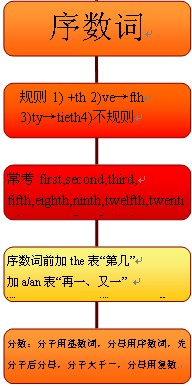本试题 “第二节完形填空(20小题;每小题1.5分,满分30分)At expert in time management was speaking to a group of students and, to drive home a point, used an...” 主要考查您对序数词
等考点的理解。关于这些考点您可以点击下面的选项卡查看详细档案。
- 序数词
序数词的概念:
表示顺序的数称为序数词。如:first, second, third, fourth。
序数词的构成与用法:
1、序数词的构成:
①一般来说,是由相应的基数词加词尾th构成。
例:four+th→fourth
six+th→sixth
seven+th→seventh
ten+th→tenth
②下面这些基数词在变为序数词时,有特殊的变化。
例:one→first
two→second
three→third
five→fifth
eight→eighth
nine→ninth
twelve→twelfth
③十位整数序数词的构成方法是将基数词的词y变成i,然后再加eth。
例:twenty→twentieth
thirty→thirtieth
forty→fortieth
ninety→ninetieth
④两位或两位以上的基数词变成序数词时,仅将个位数变成序数词。
例:twenty-one→twenty-first
thirty-five→thirty-fifth
a hundred and fifty-three→a hundred and fifty-third
2、序数词的用法:
①序数词在使用时,一般加上定冠词。
例:the first book
the second floor
the third day
the fourth week.
②序数词在多数情况下都用作定语,有的也可以作表语、主语和宾语。
例:The may1st is Labour Day. 五月一日是劳动节。
My room is on the second floor. 我的房间在二楼。
The first is larger than the secon.(主语)第一个比第二个大。
Read the book from the first.(宾语)从开头读这本书。
You'll be the sixth to write.(表语)你将是第六个写的。
③序数词的前面可以加上不定冠词,用来表示“再一”,“又一”的意思。
例:You may have a third try. 你可以第三次尝试。
序数词知识体系:

约数的表达方法:
用tens/dozens/scores/hundreds/thousands/millions of 表示“几十、几百、上千、成千上万”等。
如:The boy bought dozens of pencils.
Thousands of people died in the earthquake.
注意: (A):dozen, score, hundred, thousand, million等表示确切数量时,不用复数。
如:five dozen (of) eggs 五打鸡蛋
hree hundred people 三百个人
分数词的构成和用法:
1)分数词构成法:
分数词(FractionalNumerals)由基数词和序数词构成,基数词代表分子,序数词代表分母。除了分子为1的情况下,序数词都要用复数形式:
如:1/4:one-fourth
5/9:five-ninths
2/3:two-thirds
17/5:three and two-fifths
7/12:seven-twelfths
379/8:forty-seven and three-eighths
此外还有下面表示法:
如:1/2:a(one) half
1/4:a(one) quarter
3/4:three-quarters
9/4:two and a quarter
3/2:one and half
31/4:seven and three quarters
与“第二节完形填空(20小题;每小题1.5分,满分30分)At expert ...”考查相似的试题有:
- (2013·皖南八校联考)Singing with Sun Yang,the swimming champion,face to face is an unforgettable moment,________ th...
- We trust you; only you can ____ him to stop smoking.A.suggestB.attractC.adviseD.persuade
- 此题要求你对一段文章改错。先对每一行作出判断是对还是错。如果是对的,在该行右边横线上画一个勾(√);如果有错误(每行不会...
- 完成句子或句型转换 (共6小题15空;每空1分,满分15分)根据中文意思完成句子或根据英文句子转换句型, 每空一词。小题1:The sa...
- 信息匹配(共5小题;每小题2分,满分10分)阅读下列应用文及相关信息,并按照要求匹配信息。请在答题卡上将对应题号的相应选...
- 动词填空请用括号内所给动词的适当形式填空 (共10小题;每题1分,满分10分)The report suggests that cars with large emissi...
- It saves time in the kitchen to have things you use a lot ______ easy reach.A.nearB.uponC.withinD.around
- Li Hua was accepted by the company because he has a good ______ of spoken French.A.expressionB.commandC.powerD.ac...
- 请认真阅读下列短文,并根据所读内容在文章后表格中的空格里填入最恰当的单词。注意:每空限填1个单词。The garden city was ...
- A. Importance of Learning from FailureB. Quality Shared by Most InnovatorsC. Edison’s InnovationD. Edison’s Comment o...